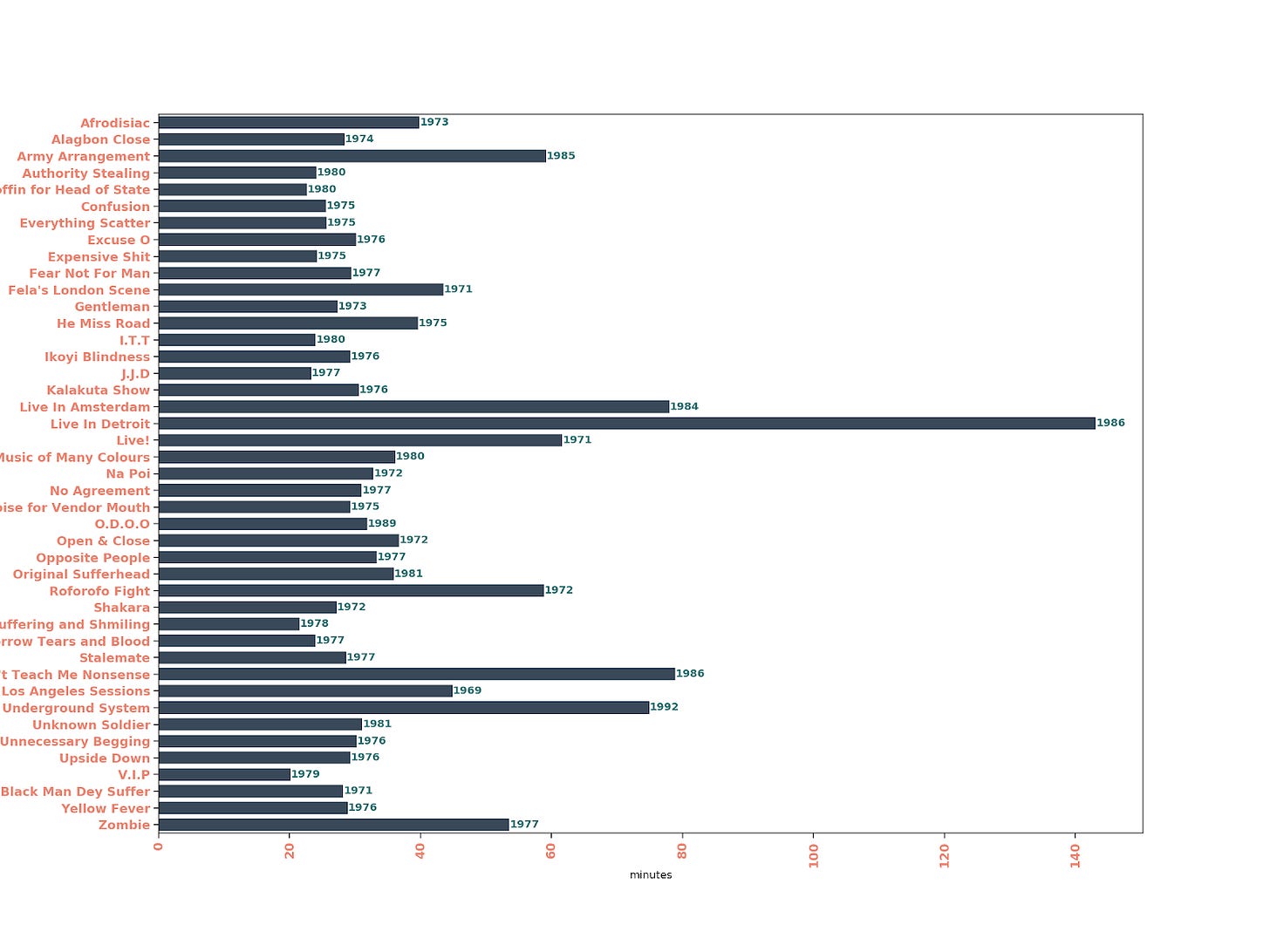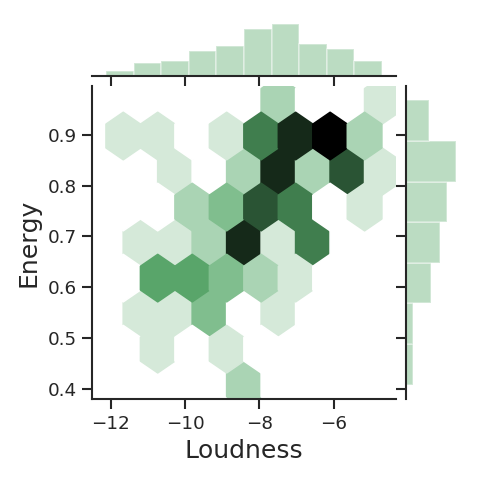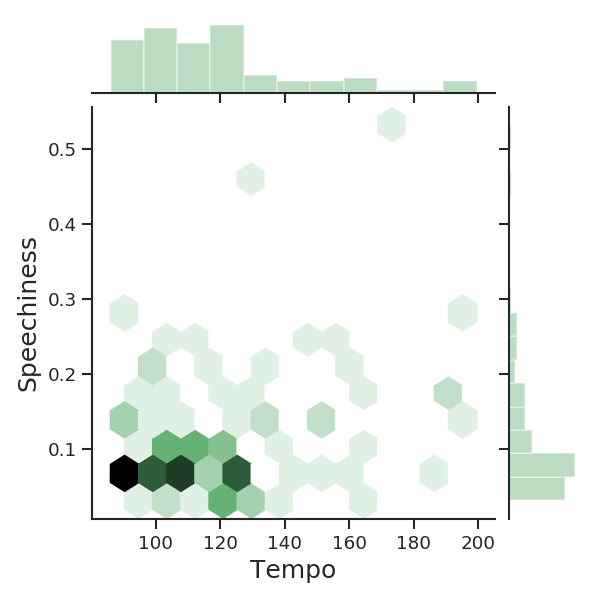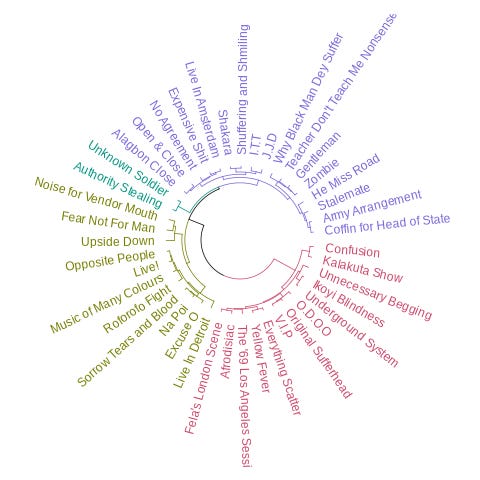An analysis of Fela Kuti's discography.
The truth can never die. - Fela Anikulapo Kuti

How long do you think a Fela song is on average? 7 minutes? 12? Or even 20 Minutes?. For a fact, Fela is famous for his long songs. Did the evolution of music recording and playing formats from compact cassettes (tapes) in 1963, to the compact disc in 1982 have anything to do with it?
Compact discs became a better alternative to tapes as it did not have the defects introduced in compression that affected recording and playing formats that came before it. It also had a larger storage capacity. This period which is now in contrast to this current era of Spotify, Apple music and Audiomack, where the length of songs is getting shorter.
Backstory
At the centre of the global Afrobeat counterculture, is Fela Anikulapokuti. Arguably Africa’s most pioneering and influential musician. He achieved iconic status with his controversial actions, charismatic demeanour and dissentious music.
By blending jazz, funk, psych-rock, and indigenous African rhythms like high life and Yoruba percussion. He invented a new progressive genre, Afrobeat.
There is an array of absurd and astonishing stories about Fela Anikulapo-Kuti(1938-97). Like his unusual marriage to 27 women on the same day. Gifting a truck full of faeces to a prominent businessman. And the 1979 march to Dodan Barracks, the headquarters of various military regimes.
Where he delivered a replica of his mother’s coffin to the then Nigerian head of state, Olusegun Obasanjo. In a symbolic gesture of ill will. After his Kalakuta residence got raided and razed by a 1000 soldiers of the Nigerian Army. An incident that resulted in his mother dying.
Fela's dissidence brought him several close calls with the government. In the 1970s most of Fela’s catalogue got blacklisted as NTBB (Not To Be Broadcast) by the state-owned media.
It was around this period that he built an interactive audience. One that converged at his communal home, called Afrika shrine. When he wasn't performing music, he spoke against the government, religion and the West.
Music for Fela wasn't only a medium for entertainment. It became a revolutionary voice of the common people during a period of oppression and dictatorship.
While Fela’s had a lot of unrecorded musical performances. All the same, it is only his published musical compositions that we can turn to glimpse an insight into hos discography. Let's take a look at his body of work and see what we find.
Getting & Analyzing The Discography Data
Spotify offers a cool feature (API) that allows anyone to explore their music database and extract audio features. These features contain a considerable range of metrics. That relates to the content and structure of a song.
Some of these features measure the objective properties of a song. while others measure subjective properties like how danceable or positive a song is.
In total the dataset collected from Spotify contained 43 albums and 105 songs. Spanning a period of 24 years from 1969 to 1992.
There are currently 13 audio features that come with every song from the Spotify API. Here's a description of each audio feature:

Fig 1: Distribution of audio features for Fela’s discography
There are currently 13 audio features that come with every song from the Spotify API. Here's a description of each audio feature:
Acousticness outlines whether a song uses primarily acoustic instruments (guitar, piano or trumpets) or electronic/electric instruments. A value of 1.0 indicates that a song is purely acoustic, and a value of 0 shows that a song was made purely from electronic instruments.
Danceability shows if a track is suitable for dancing based on a combination of musical elements including tempo, rhythmic stability, beat strength, and overall regularity. A song with a danceability value of 1.0 indicates it is a highly danceable song. 0 value indicates a low danceable song.
Duration / Length (minutes) shows the length of the song.
Energy is a perceptual measure of intensity and activity. Energetic tracks are usually dense, fast, loud, and noisy. The measure of a track’s energy is from 0 to 1.0.
Instrumentalness illustrates whether a track contains no vocals. “Ooh” and “aah” sounds are treated as instrumental in this context. Rap or spoken word tracks are clearly “vocal”. The closer the instrumentalness value is to 1.0, the greater likelihood the track contains no vocal content. Values above 0.5 are intended to represent instrumental tracks, but confidence is higher as the value approaches 1.0.
Liveness detects the presence of an audience in the recording. High liveness values represent an increased probability that the song was performed and recorded live. It seems that most of Fela’s tracks are studio-recorded.
Loudness describes the overall loudness of a track, measured in decibels (dB). Loudness is the quality of a sound that is the primary psychological correlate of physical strength (amplitude). Values typical range between -60 and 0 dB. With 0 dB being the threshold of human hearing ability and negative dB indicating that you are a few times softer than that threshold.
Mode indicates whether a song is in primarily a major key or a minor key. Major keys tend to have a cheerful melody; while minor keys sound more melancholy and sad.
Popularity is a measure of how often the song has been streamed on Spotify.
Speechiness indicates the presence of spoken words in a song. The more exclusively speech-like the recording (ex. talk shows, audiobooks, etc.), the closer the speechiness is to 1.0. The distribution of Speechiness in Fela’s discography shows that his songs do not contain a lot of speech (lyrics).
Tempo is the speed or pace of a given track, measured in beats per minute (BPM). Tempo roughly appears to be normally distributed around 110BPM for Fela's catalogue.
Time signature is a notational convention to specify how many beats are in each bar of music. Most of Fela’s songs are 4 beats per bar, but a small number of hits have 3 beats per bar, also known as the triple meter. These are probably slower tracks.
Valence indicates the musical positiveness conveyed by the song. In other words, songs with high valence sound more happy/positive/cheerful while songs with low valance sound more negative/depressed/angry. The data shows that Fela’s songs are more likely to have a high valance.
How did the years affect Fela’s music?

Fig 2: Number of songs per year by Fela
The ’80s show a drastic reduction in the number of songs that Fela released. When Fela's career started, he released lots of songs, however as time went by, the number of songs dwindled. This contrast can be seen in Fig 2. In the ‘70s, Fela released a cumulative 71 songs, in the ‘80s he released a cumulative of 21 songs.
Which songs by Fela should you be dancing to?

Fig 3: A box plot showing the Danceability of Fela’s songs over time.

Fig 4: A plot of Fela’s top 7 danceable songs.
If you are looking to add songs from Fela catalogue to a dance playlist. Then you’ll have to strongly consider You no go die unless and Dont worry about my mouth o. From 1971 to 78’, Fela’s music seem to be very dancy.
Overtake don overtake is the only song that from the 80’s that made Fela’s top 7 danceable songs list.
Finding Positivity in Fela’s music

Fig 5: A box plot showing the Valence (Positiveness) of Fela’s songs over time.

Fig 6: A plot showing Fela’s top sad songs.
It’s a bit unusual to see that Black man’s cry and Government chicken boy are Fela’s most happy songs if you take their name at face value. Indeed, Fela was an unusual man.
In the box plot graph of songs valence, there’s only one outlier, Kalakuta Show. Which is Fela’s most sad song.
Investigating Fela’s Instrumentality

Fig 7: A plot showing the Instrumentalness of Fela’s songs over time.

Fig 8: A box plot showing the Speechiness of Fela’s songs over time.
In Fig 7, we see that Fela had more instrumental songs in the ‘70s than in the ’80s. This could be in part attributed to his band, Afrika’s 70. Yet, you’ll expect songs in the ’80s to have more vocal content than the ’70s but Fig 8 tells another story.
Even though his songs were more instrumental in the '70s than the ’80s. Those ‘70s songs still had more spoken words than the songs from the decade that followed.
How long is long enough?

Fig 10: A box plot showing the duration of Fela’s songs over time.

Fig 11: A plot showing the length in minutes of each Fela album.
The average duration of a Fela track is 15 minutes. Fig 10 image shows a steady rise in track length of Fela’s discography from the ‘70s on towards the ’80s.
Fela’s longest album is Live in Detroit. Recorded live during the Detroit concert at the Fox Theater in Detroit, November 1986. This concert was part of Fela's debut US tour with his Egypt 80 band.
Mr Energetic

Fig 12: A box plot showing the energy of Fela’s songs over time.
Fela’s energetic personality was very evident in his songs. Throughout his career, his energy never faded but continued to remain steady.
Clustered albums and correlating audio features

Fig 13: A Correlation Map of audio features of Fela’s discography.
Correlations allow us see the relationships between two or more things. In this case, the audio features of Fela’s discography. The interesting correlations found in this data are:

Fig 14: Jointplot of Energy and Loudness features of Fela’s discography.
Energy and Loudness have a moderate correlation of 0.51. A jointplot shows the relationships between two variables. Fig 14 shows that Fela’s loud songs tend to be energetic.

Fig 15: Jointplot of Danceability and Tempo features in Fela’s discography.
Tempo and Danceability have an inverse correlation of -0.35. The Jointplot in Fig 15 reveals that the Fela’s danceable songs usually have a tempo between 90 and 130 beats per minute.

Fig 16: Jointplot of Livesness and Danceability features in Fela’s discography.
Liveness and Danceability have an inverse correlation of -0.49. Fig 16 shows that tracks that were not performed live tend to be more danceable.

Fig 17: Jointplot of Acousticness and Loudness features in Fela’s discography.
Acousticness and Loudness also have an inverse correlation of -0.39. In Fig 17 we see that tracks created mostly with electric or electronic instruments tend to be louder.

Fig 18: Jointplot of Tempo and Speechiness features in Fela’s discography.
Tempo and Speechiness are weakly correlated with a value of 0.31. Fig 18 shows that songs that have a tempo 90 to 130 beats per minute tend to low amount of spoken words.

Fig 19: A dendrogram showing the clusters of Fela albums
A dendrogram shows the arrangement of clusters produced from a hierarchical clustering algorithm that groups similar objects into groups called clusters. In Fig 19, we can see that Fela’s albums have 4 clusters.
Green: Fast-paced tracks made without acoustic instruments
Purple: This cluster contains songs that are energetic, slow-paced and danceable.
Yellow-Green: This cluster contains songs that are purely energetic.
Red: A cluster of songs that contain vocal content (low instrumentalness).
Conclusion
It is tempting to try and separate Fela’s musical lifespan into two decades; the 70’s and the 80’s. But his impact on music globally, through the creation of the Afrobeat genre, and the use of his music as a weapon for the common man depicts a man that can not be quantified with numbers.
These numbers can only give insights into part of the underlying structure of his work and not the hard work and models that went into producing his music.
Fela was a lot of things but music was the foundation of his essence. And it's this music that has become the foundation of one of Africa’s greatest export to the world.
If you enjoyed this post, please consider subscribing. If you know someone who might like his piece, feel free to forward this directly to them by using the share button below.
Notes



